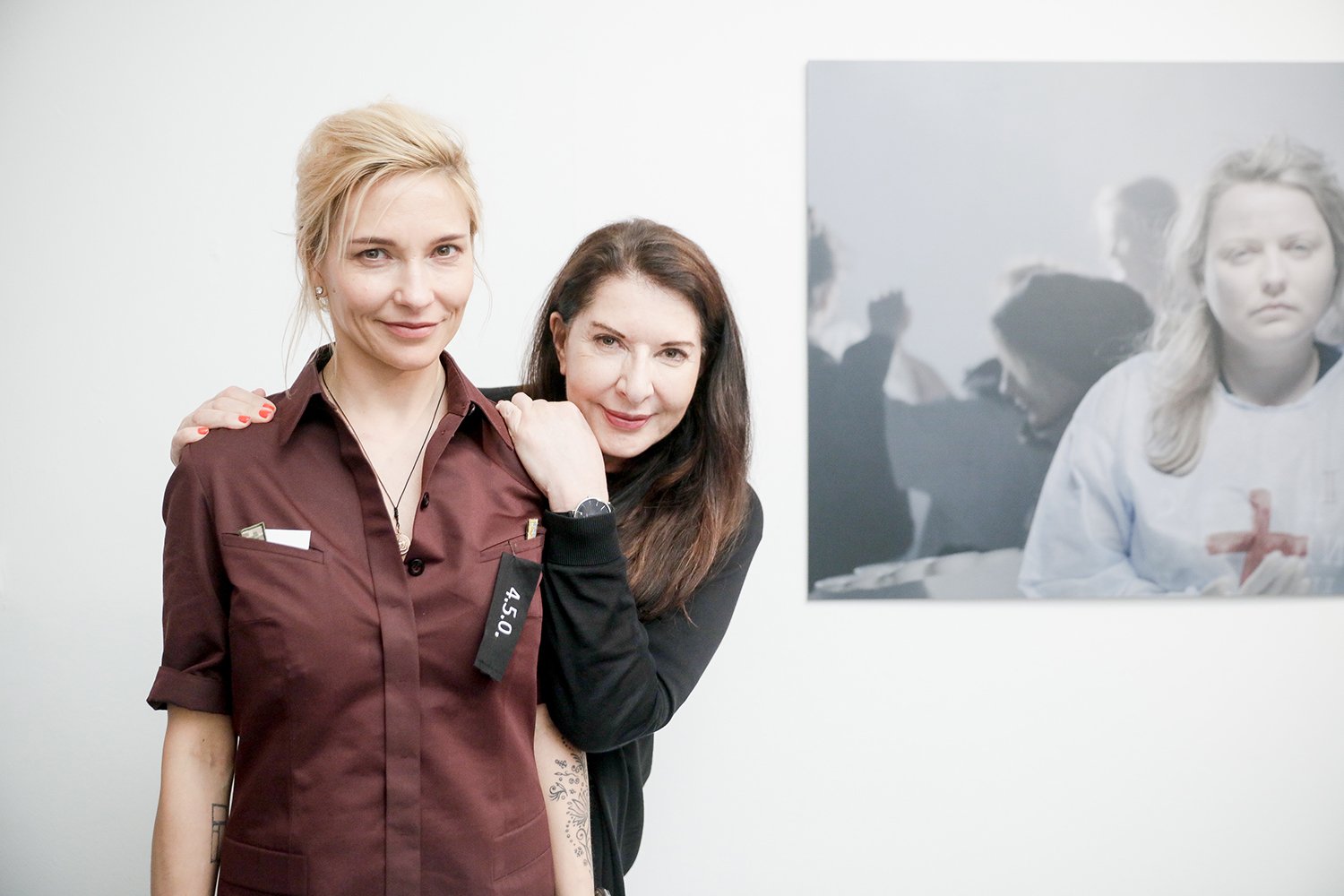
As a young artist, Ukraine’s Zinaïda Kubar can already claim two rare accomplishments. Not only has she studied with the one and only Marina Abramović, her New York City debut was fêted with a party hosted by the towering performance artist. Zinaïda—who goes by her first name—staged a dramatic piece inspired by the strength of the women of her native country during her WhiteBox opening on Friday. If the post-show celebration was any indication, the master was pleased with her protege.
The show began even as guests filtered into the gallery: Three women—all Ukrainian models—slipped into the space, clad in simple light-brown dresses based on traditional Ukrainian garb. A pile of bright red kalyna berries, a national symbol of Ukraine, were heaped on the floor in the center of the room. (The plant’s Latin species name is Viburnum, and it is known in the US as the guelder-rose or the snowball tree.)
“In Ukrainian tradition, kalyna is a talisman of femininity, purity, and virginity,” Zinaïda, who goes by her first name, told artnet News a few minutes before the performance began, admitting that she snuck the fruits through customs illegally. The piece, titled Kalyna, played on those associations while also referencing more recent history in Ukraine, a country that has been locked in armed conflict since the spring of 2014.
Zinaïda’s performance Kalyna at the opening of “Zinaïda: 4.5.0” at WhiteBox. Photo courtesy of Charles Roussel.
“We have a war,” Zinaïda said. “A lot of women are losing fathers, sons, and brothers because of the fighting.” The artist sees the kalyna berries as representing both the bloodshed in the ongoing conflict and the way in which those events have affected women, forcing young girls to grow up quickly.
“These events make us strong,” she added. “It’s about blood, and life, and losing virginity.”
Slowly, one of the women approached the berries, knelt down, and pressed a handful of the juicy fruit to her chest. “She’s showing how she’s suffering,” Zinaïda explained. The red stain also mimicked a namysto, a traditional Ukrainian necklace of red beads that functions as a sort of protective amulet—here subverted as a symbol of pain.
Zinaïda’s performance Kalyna at the opening of “Zinaïda: 4.5.0” at WhiteBox. Photo courtesy of Charles Roussel.
Zinaïda began making performance art four years ago. “I applied to be a facilitator for Marina Abramović. I got lucky and I went to Australia and worked with her for two weeks,” she said. Zinaïda has continued studying with the performance art master, applying the lessons she has learned to her burgeoning practice.
“I believe art should be like air: sometimes you make objects, and sometimes you make actions,” she said. The exhibition also includes her related video art, which looks to inform audiences about the ongoing crisis in Ukraine. (“It is not an easy topic I chose for this,” she admitted.)
On the walls hung Mute, a group of 16 portraits of women and young girls who Zinaïda met in the protest camps during the 2014 Maidan Revolution in Kiev, after the president decided not to sign the Ukraine–European Union Association Agreement. Following the revolution, Zinaïda did a photoshoot in a studio, recreating the moment in high-definition video portraits, her subjects calm and serene amid the chaos of the protest around them.
Zinaïda,Mute: Olesya, on view in “Zinaïda: 4.5.0” at WhiteBox. Photo courtesy of WhiteBox.
Ahead of the exhibition, Zinaïda got back in touch with her subjects, interviewing them about their lives today and finding that many of them had gone on to get involved in the government. These short texts hang next to still images from the video portraits, which are purposely silent: Zinaïda wanted to capture all the emotions and feelings that they couldn’t express in words through just the look in their eyes.
The piece is about the power of women, who Zinaïda believes are the key to the country’s future. “The political situation is very bright. I believe we are in a state of transformation,” she said. “I’m trying to show that women have the power to transform the situation, to create healing and rebirth.”
That’s a goal she’s been working on herself, through ARTREHUB, a new art-focused soldier rehabilitation program she created in collaboration with Ukrainian hospitals. Though Zinaïda wanted to aid her country, “I couldn’t go to fight in the war because it’s not my language; I’m an artist,” she explained. “But I can help soldiers adapt to society when they come back from war.”
Having already worked with some 200 soldiers back home, Zinaïda is looking to stage art rehabilitation programs in New York during the exhibition’s run and has reached out to several local veterans’ groups.
“This is cultural diplomacy for me,” she said. “This is my act for Ukraine. I feel a great responsibility.”
See more photos from the exhibition below.
Zinaïda,Mute: Valentina, on view in “Zinaïda: 4.5.0” at WhiteBox. Photo courtesy of WhiteBox.
Zinaïda,Mute: Lyudmila, on view in “Zinaïda: 4.5.0” at WhiteBox. Photo courtesy of WhiteBox.
Zinaïda’s performance Kalyna at the opening of “Zinaïda: 4.5.0” at WhiteBox. Photo courtesy of Charles Roussel.
Zinaïda,Mute: Anastasya, on view in “Zinaïda: 4.5.0” at WhiteBox. Photo courtesy of WhiteBox.
Zinaïda,Mute: Oksana, on view in “Zinaïda: 4.5.0” at WhiteBox. Photo courtesy of WhiteBox.
Zinaïda’s performance Kalyna at the opening of “Zinaïda: 4.5.0” at WhiteBox. Photo courtesy of Charles Roussel.
“Zinaïda: 4.5.0” is on view at WhiteBox, 359 Broome Street, New York, June 1–July 5, 2018.